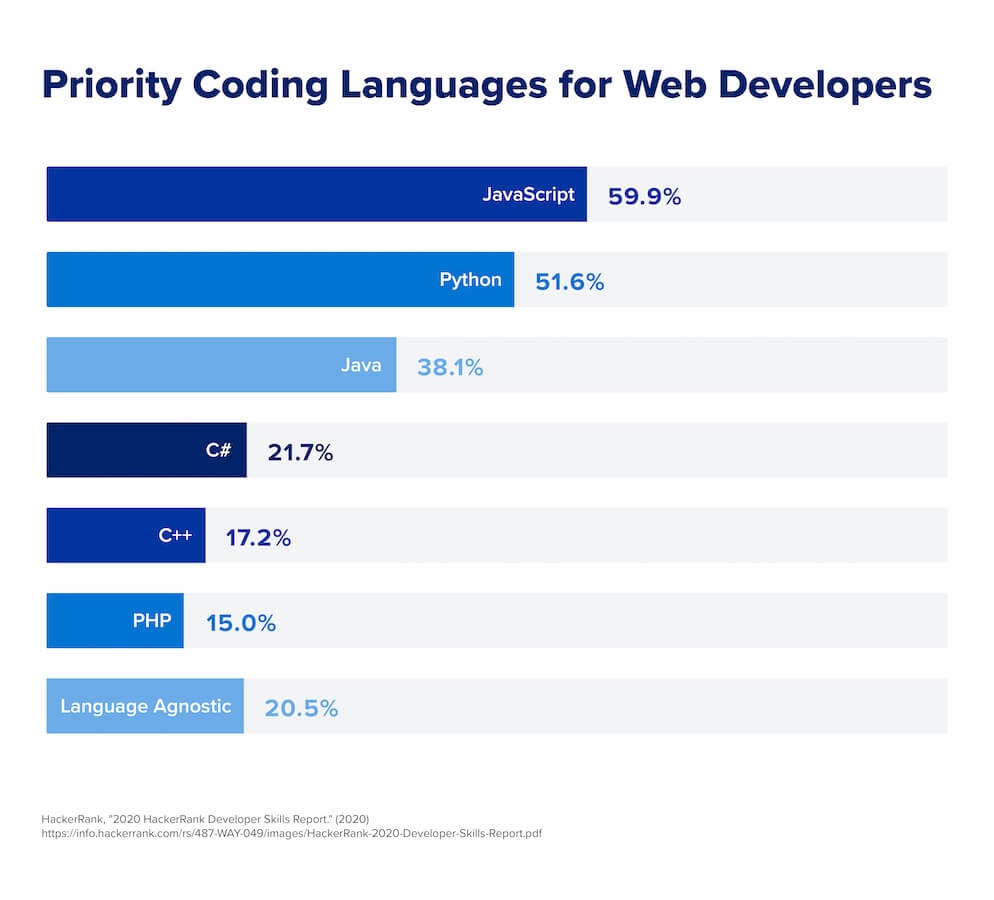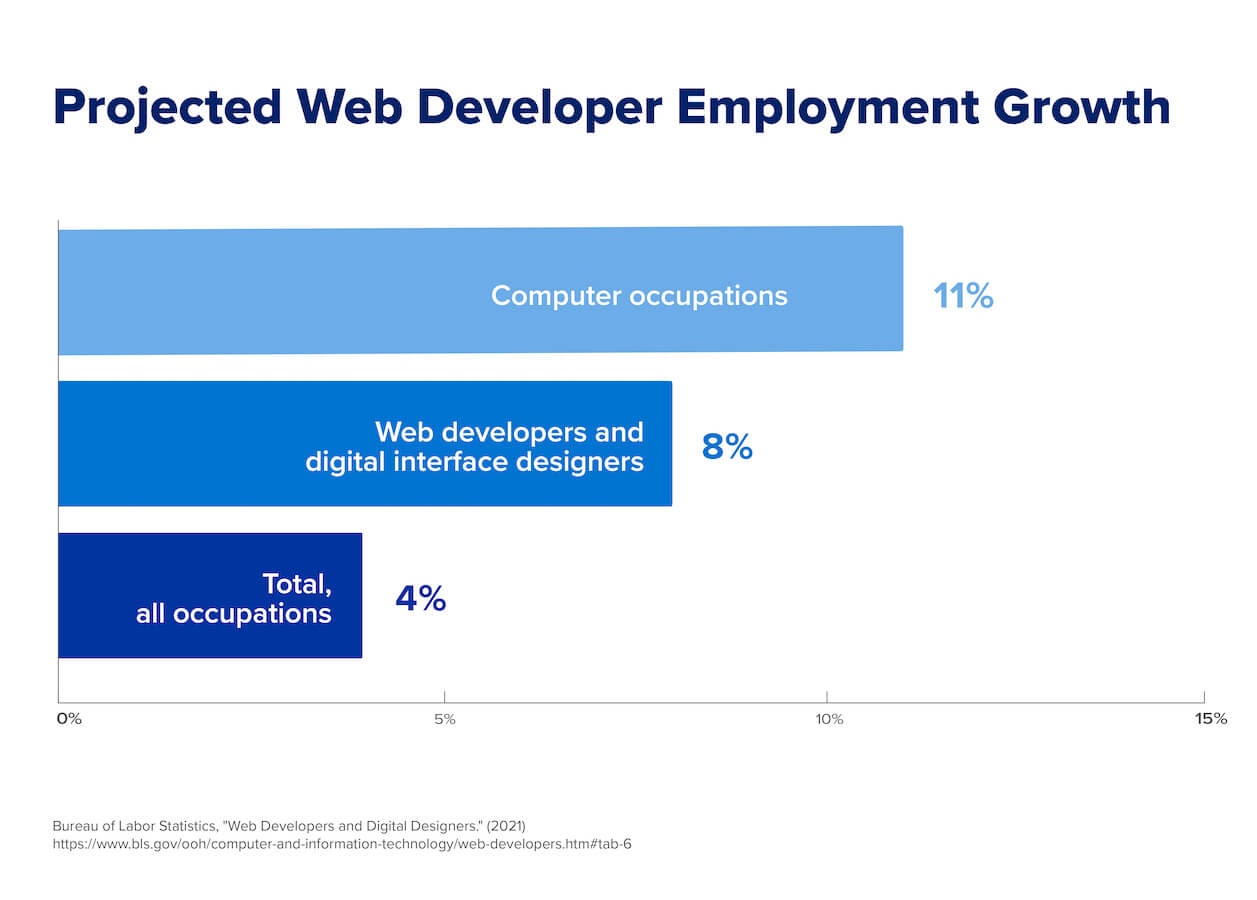Coding 101: Understanding the Basics
High-level programming languages have existed since the 1950s, when languages like FORTRAN (Formula Translator) and ALGOL (Algorithmic Language) expanded upon early assembly languages, allowing programmers to solve computing problems. Today’s code is both more complex and increasingly important, as it builds the layered operating systems, software, and websites we use on a daily basis. This broad-based usage has made coders a vital part of our collective digital infrastructure.
To get started in this enduring field, it is important to first establish the basics of coding and how it works.
A Simple Definition of Coding
At its core, coding is a way for programmers to communicate with computers. Programmers use coding languages to give computers instructions on how to perform tasks — code is what makes up the computer programs, smartphone apps, and websites you use every day. Nearly every functional aspect of digital technology exists as a result of underlying code.
Coding Examples — What Does Coding Look Like?
There are many different types of code (also known as programming languages) that are used in different situations for different purposes. For example, languages like HyperText Markup Language (HTML) and Structured Query Language (SQL) serve different, yet important roles in building and maintaining digital assets. Understanding these languages is crucial for any front end web developer, as they contribute to the design and maintenance of an entity’s various client-facing components. Here is a quick overview of a few coding language applications:
In web development, HTML provides the basic structure for most websites, detailing how website elements are laid out on a page. For instance, including “<p>” on either end of a line of text communicates that the text should be treated as a paragraph.
Cascading Style Sheets (CSS), on the other hand, are used to style and change the visual appearance of a webpage. In this case, the code <h3 style=”color:green;”>Introduction</h3> would produce a heading titled “Introduction” in green font.
SQL is another great example of a widely-used language — it is used to manage, change, and organize data within databases. For instance, let’s say you want to pull a list of customers from your company’s internal database. Writing an SQL query would let you find the right customers for the marketing team to contact. This query may look something like this: SELECT CustomerName,City FROM Customers;.
How Does Coding Work?
Coding is the entire underlying science of web and software development. Today’s computers, apps, and operating systems may be sophisticated and versatile, but they can only achieve their purpose if they are properly told what to do. This is where coding comes into play. Programmers give these technologies the roadmap they need to operate as intended, writing complex back end commands that lead to desirable front end performance.
That said, computers can only understand instructions that are in a machine language, also known as binary code. You may have seen this type of code before — it’s a language made up of numbers that informs a computer on how to execute specific functions. Coding allows programmers to write complex instructions using symbols and words, which are more understandable for humans, without needing to write it in machine language. Then, once the code is written, a compiler is used to convert the code into a machine language (binary code) so the computer can execute it.
How Is a Piece of Code Executed?
Code execution refers to the process of a computer taking the code you’ve written and running the instructions and commands as indicated. In other words, once the computer is able to understand what you are saying, it knows exactly what to do. Execution can involve showing images on the screen, inputting data into a database, or performing calculations — whatever actions are specified by the code written by the programmer.
What is Computer Code Used For?
Computer code is used across most industries to fulfill a wide range of functions. For instance, the cybersecurity field has recently sought programmers to help digitally secure a growing variety of internet of Things (IoT) devices, while healthcare and finance need programmers to fortify their increasingly data-driven infrastructure and help protect sensitive information.
Many important products and services rely on coding to deliver value to customers. For example, Uber used coding to build an app that connects drivers with riders needing to reach a destination. The efficiencies involved in the process allowed Uber to create a completely new type of ride-sharing service and become the massive company they are today.
Why Are There So Many Programming Languages?
Programming languages are tools used to fulfill different roles; think of them as if they were different types of vehicles: a bicycle, pickup truck, and sports car are all vehicles used to move people or objects, but they all have their own unique purpose and use case. You wouldn’t want to haul plywood in a sports car, and a pickup truck couldn’t beat a sports car in a drag race. Similarly, different programming languages have different strengths and weaknesses that make them the right choice for different situations.
Like vehicles, most programming languages can accomplish similar tasks, but they’re often used for different scenarios. For example, Java is often used to develop desktop applications, video games, and mobile applications. Python, on the other hand, is used in a variety of back end applications related to business development, audio- and video-based media, and website data analysis. Meanwhile, Swift is used to develop applications across Apple devices. Understanding the strengths and weaknesses of individual programming languages can help you figure out which languages you want to learn initially, as you get started, and then which languages you should learn throughout your career. It’s important to realize that being a programmer means having a commitment to life-long learning as technology evolves, user requirements change, and your skills continue to grow .

 Live Chat
Live Chat

